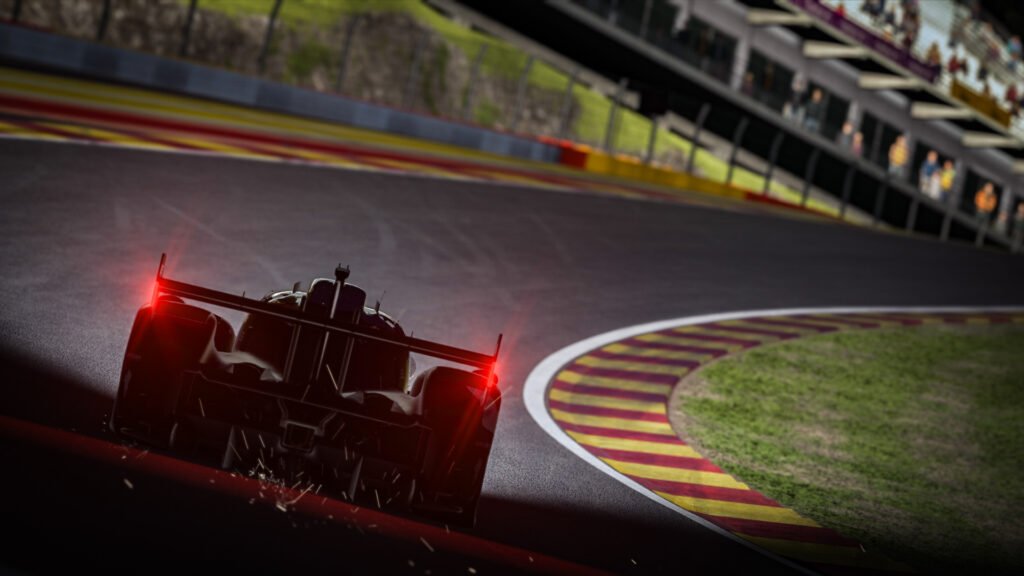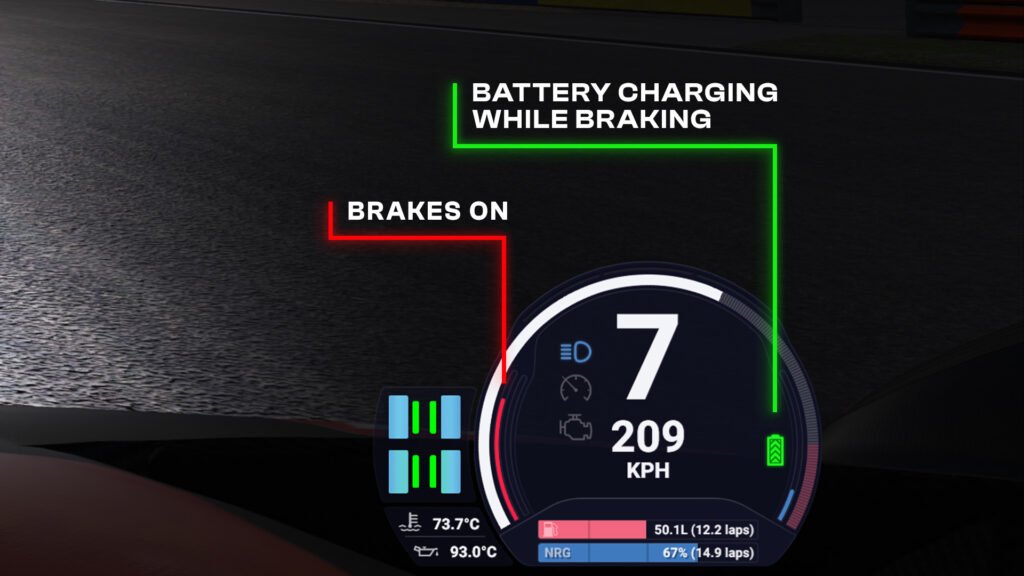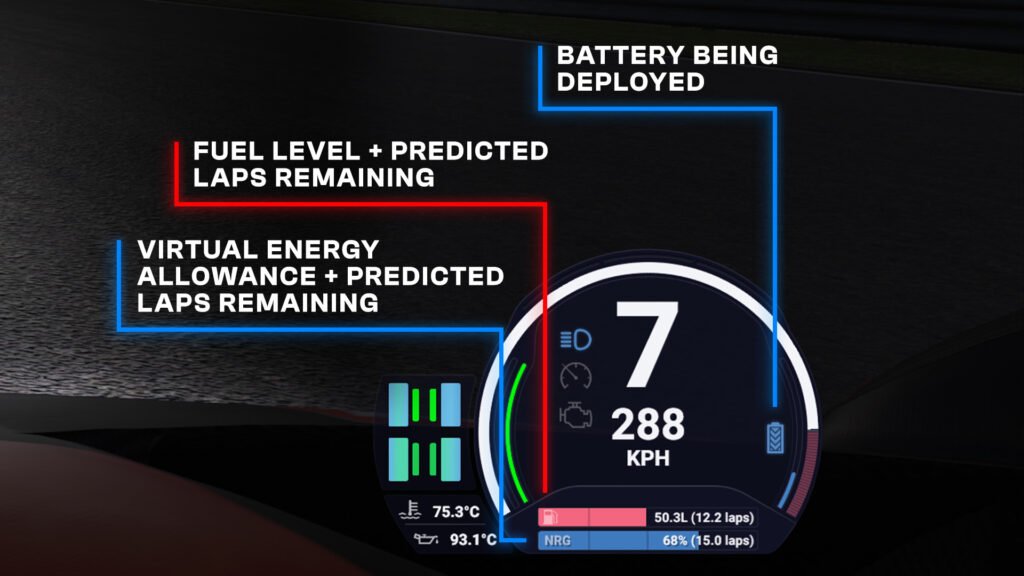You probably already know that Le Mans Ultimate is the official game of the FIA World Endurance Championship.
But what you may not be aware of is that Studio 397 has successfully implemented the series’ Hypercar rules, where each car receives an allotted amount of ‘Virtual Energy’ per stint, combining petrol and battery power regenerated via braking.
Below, we’ll talk you through the subtle variations in LMU’s Hypercar class and how best to manage your virtual energy tank during a race. This will not only help you achieve quick lap times but also allow you to run longer stints.

What is the virtual energy tank in WEC?
Virtual energy is the allotted quantity of energy a Hypercar can use during a race stint. This consists of both hybrid power and conventional fuel, with the final output of the car calculated by a torque sensor and monitored by the FIA.
What are the differences between LMH and LMDh Hypercars in Le Mans Ultimate?
To understand the virtual energy system, first, we need to establish the differences between LMU’s Hypercars.
Hypercars are split between LMDh and LMH rules. LMH cars in LMU – which include the Ferrari 499P, Peugeot 9X8, Vanwall Vandervell 680, Glickenhaus SCG 007 LMH and Toyota GR010 Hybrid – have been fully designed and built by the manufacturers.
What is an LMH car?
LMH cars can have hybrid elements but aren’t obliged to include them, as is the case with the Vanwall and Glickenhaus entries. Choosing the LMH route allows manufacturers to add a motor generator unit (MGU) to the front axle, allowing four-wheel-drive above certain mandated speeds (above 190 kph in dry conditions, for the Ferrari, 2024 Peugeot and Toyota, and 150 kph for the 2023 Peugeot).

What is an LMDh car?
An LMDh car, however, only has an MGU on the rear axle. To keep costs down, LMDh entrants must use a bigger range of spec parts, including the MGU, battery and gearbox. They also have a choice of four chassis, but can at least source and develop their own engine and aero packages.
LMDh cars in LMU include the Porsche 963, BMW M Hybrid V8, Cadillac V-Series.R and Lamborghini SC63.
LMH cars in Le Mans Ultimate
- Ferrari 499P
- Peugeot 9X8 (2023 – also raced at Round 1 of the 2024 season in Qatar)
- Peugeot 9X8 (2024)
- Toyota GR010 Hybrid
- Vanwall Vandervell 680 (2023 only)
- Glickenhaus SCG 007 (2023 only)
LMDh cars in Le Mans Ultimate
- BMW M Hybrid V8 (2024)
- Cadillac V-Series.R
- Lamborghini SC63 (2024)
- Porsche 963*
Who decides the Hypercar Balance of Performance calculation?
The FIA and ACO decide on every vehicle’s BoP in WEC and, ultimately, LMU, to help ensure a level playing field among the various Hypercar configurations.
WEC is run and organised by the FIA, the world’s largest motorsport governing body, and the Automobile Club de l’Ouest (ACO). The ACO is France’s biggest automotive group and the organiser of the 24 Hours of Le Mans (its role is similar to that of ADAC in Germany).
The BoP allows the FIA and ACO to adjust power, weight and aero drag figures for all Hypercars, but full details of each car’s BoP are never revealed.
Teams can be fined for discussing the BoP publicly, even when reacting to controversial circumstances like when Ferrari was granted a significant weight advantage over Toyota ahead of the 2023 edition of Le Mans.

Also covered by the BoP is the amount of ‘virtual energy’ a car can use per race stint. Virtual energy (noted as ‘NRG’ on LMU’s in-game HUD) is the combined amount of hybrid battery and petrol power allowed in a stint.
Virtual energy is monitored by the FIA via onboard torque sensors, giving them an overall energy usage figure per car (thought to be around 900 MJ per stint, varying slightly per manufacturer).
LMH and LMDh MGU regen and deployment figures
All Hypercars are allowed to run with a combined total of 500 kW / 671 bhp, split between electrical and internal combustion engine (ICE) power, with LMH MGUs capable of producing 200 kW / 268 bhp. LMDh cars, on the other hand, use a spec Williams Advanced Engineering-developed hybrid system which produces just 50 kW / 67 bhp, meaning an LMDh car’s virtual energy tank consists of a higher proportion of petrol than an LMH’s.
Note: the MGU doesn’t provide a boost over and above the allowed 671 bhp, it temporarily replaces power created by the ICE. Torque sensors located on the cars’ driveshafts constantly monitor the combined power output to ensure it doesn’t exceed 671 bhp. A faulty torque sensor can lead to penalties, so teams have to ensure their reliability.

How does virtual energy work?
Hypercars’ batteries are charged by repurposing heat energy created by braking. The heat energy is stored as electrical energy and can be deployed by the MGU. LMH cars can deploy up to 200 kW, while LMDh cars can only deploy up to 50 kW. However, there are no speed restrictions on when LMDh cars can deploy this electrical assistance.
The energy provided by the battery replaces the equivalent petrol power, so adjusting the Electrical motor map setting to 200 kW will effectively replace 200 kW of power from the ICE. Using more electrical power minimises the amount of fuel required over a stint, helping lower the overall weight of the car This also helps improve tyre life and lap times.
When the battery charges, the battery icon on the bottom right section of the in-game HUD will flash green (as pictured below) and when it’s deploying it will flash blue. When not charging or discharging, the battery icon will be grey and empty (like Peugeot’s Hypercar trophy cabinet).

How to manage regen and the motor map in Le Mans Ultimate
In LMU, the rate at which the battery is charged and discharged can be decreased and increased by juggling your car’s ‘Regen level’ and ‘Electric motor map’ settings (make sure to map these to your steering wheel as they’re vitally important in endurance races).
Increasing the regen level effectively increases your braking power, creating more heat and harvesting more energy under braking. This charges the battery quicker. In theory, lowering the regen level should result in overheating brakes but this doesn’t seem to play out in LMU. Which is good for sim racers.

LMH cars can harvest 200 kW of energy through braking, while LMDh cars can only regenerate a maximum of 170 kW.
Run with maximum regen settings to optimise braking performance and battery regeneration (on both LMH and LMDh cars), while switching between 40 kW and 60 kW motor map settings during a stint with LMH cars (50 kW works just fine for LMDhs).
This will provide a balanced approach between discharging enough battery to improve braking performance and using enough electrical energy to maximise fuel economy.
Using lift and coast to extend stints in Le Mans Ultimate
For the uninitiated, lifting and coasting refers to the technique where a driver lifts off the throttle pedal partially or completely before a corner’s braking zone, using the car’s aerodynamic drag to slow it down.
This saves ICE fuel but also regenerates less electrical energy under braking. To save further ICE energy, you can short-shift up through the gearbox.

If you use the above techniques successfully, you can run your car with less fuel. Less fuel equals less weight, which equals better performance and lower lap times. Remember, electrical energy weighs nothing, so successfully combining energy from the ICE and MGU is the most efficient way to complete a stint.
To add or reduce the amount of fuel in your car you must adjust the ‘Fuel Ratio’ setting in the Powertrain section of the car set-up menu.
If you’re heading to the pits for a splash and dash then keep the fuel ratio setting the same and simply adjust the overall ‘Virtual Energy’ figure. Increasing the fuel ratio will only increase the length of time you’re stationary in the pits.
LMU offers a handy guide on how many laps a full allotment of virtual energy will last alongside how many laps of fuel you have left (see image below). Keep an eye on these as they refresh each lap based on your driving style. It will also help you judge your fuel ratio setting for future stints.

Le Mans Ultimate: The four biggest mistakes
Four crucial pitfalls must be avoided in LMU. These are:
Reaching 100% battery charge during a stint
Once your battery reaches 100% charge, your brakes won’t work at their maximum potential.
The MGU can’t generate any more electrical power under braking while the battery is full, so its extra ‘engine braking’ service will be rendered ineffective. This can cause brake lock-ups and increased braking distances, which you really don’t want in an endurance race (if this scenario arises, an LMH car is more likely to lock its rear wheels while an LMDh car is more likely to lock its fronts due to the shift in brake balance).
To prevent this, ensure you discharge enough of your battery by increasing the motor map setting. This is especially important on the first lap of a race before the first important braking zone.
Pitting with 0% battery charge
If you’re driving an LMDh car that uses electrical power in the pitlane (the Porsche 963 and Cadillac V-Series.R, for example), make sure you have some battery power left before boxing. Otherwise, when your pitstop is over your car won’t be able to restart!
Going over your allotted virtual energy allowance (NRG)
If you use more than your car’s allocated amount of virtual energy in a stint (noted by the NRG bar), you will be given a 100s stop-and-go penalty. Not only that, but for every infringement afterwards the penalty will be increased by a further 100s.
Not advisable, then.
Adding too much fuel
Put simply, your car will not require a full tank of fuel for a race stint (unless it’s one of the ICE-only LMH cars). So, determining how much fuel you require may take a few practice laps, but this could pay dividends come race time.
Adjust the ‘Fuel Ratio’ setting described earlier to prevent over-fuelling.

TL;DR – Le Mans Ultimate Virtual Energy at a glance
If you’ve simply skipped to the end of this article – and I can’t blame you if you have – the basic principles of managing virtual energy in LMU are these:
- Run Hypercars’ Regen Level as high as possible
- Don’t let your battery charge drop to 0% before a pitstop, if driving an LMDh
- Don’t let your battery level reach 100% at any point
- Practice to find out the ideal fuel ratio setting
- The Vanwall Vandervell 680 and the Glickenhaus SCG 007 don’t have hybrid systems
- Generally set your LMH car’s motor map at 40/60 kW for a race stint
- Drain your LMH’s battery quickly by setting a high motor map in the early stages of a race. This way your brakes will work optimally at the first braking zone.
- Jernej Simončič knows a lot about Le Mans Ultimate. Many thanks to him for his insight!
- Don’t mess with the FIA
*Lists correct as of 8/8/24





Chat with the Community
Sign Up To CommentIt's completely Free